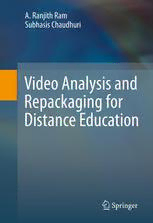
Video Analysis and Repackaging for Distance Education PDF
Preview Video Analysis and Repackaging for Distance Education
Video Analysis and Repackaging for Distance Education A. Ranjith Ram • Subhasis Chaudhuri Video Analysis and Repackaging for Distance Education A. Ranjith Ram Subhasis Chaudhuri Government College of Engineering Indian Institute of Technology, Bombay Kannur, Kerala, India Powai, Maharashtra, India “This book is an independent publication and is not affiliated with, nor has it been authorized, sponsored, or otherwise approved by MOTOROLA, and/or any of their subsidiaries. References to various MOTOROLA copyrighted trademarks, characters, marks and registered marks owned by MOTOROLA and/or any of its subsidiaries may appear in this book. Rather than use a trademark symbol with every occurrence of a trademarked name, logo, or image we use the names, logos, and images only in an editorial fashion with no intention of infringement of the trademark.” ISBN 978-1-4614-3836-6 ISBN 978-1-4614-3837-3 (eBook) DOI 10.1007/978-1-4614-3837-3 Springer New York Heidelberg Dordrecht London Library of Congress Control Number: 2012938479 © Springer Science+Business Media New York 2012 This work is subject to copyright. All rights are reserved by the Publisher, whether the whole or part of the material is concerned, specifically the rights of translation, reprinting, reuse of illustrations, recitation, broadcasting, reproduction on microfilms or in any other physical way, and transmission or information storage and retrieval, electronic adaptation, computer software, or by similar or dissimilar methodology now known or hereafter developed. Exempted from this legal reservation are brief excerpts in connection with reviews or scholarly analysis or material supplied specifically for the purpose of being entered and executed o n a computer system, for exclusive use by the purchaser of the work. Duplication of this publication or parts thereof is permitted only under the provisions of the Copyright Law of the Publisher’s location, in its current version, and permission for use must always be obtained from Springer. Permissions for use may be obtained through RightsLink at the Copyright Clearance Center. Violations are liable to prosecution under the respective Copyright Law. The use of general descriptive names, registered names, trademarks, service marks, etc. in this publication does not imply, even in the absence of a specific statement, that such names are exempt from the relevant protective laws and regulations and therefore free for general use. While the advice and information in this book are believed to be true and accurate at the date of publication, neither the authors nor the editors nor the publisher can accept any legal responsibility for any errors or omissions that may be made. The publisher makes no warranty, express or implied, with respect to the material contained herein. Printed on acid-free paper Springer is part of Springer Science+Business Media (www.springer.com) To DearestGita,KamalandKirtana ARR. Raj,Shankarandallmyteachers SC. Preface Thetertiarysectorofoureconomyrequiresthatasignificantportionofthepopula- tionbewelleducated.However,avastmajorityofthepopulationindevelopingand under-developedcountriesdonothaveaproperaccesstohighereducation.Higher education is expensive and, quite often, there are not enough qualified teachers in thelocality.Educationisahuman-intensivetrainingprogramandwerequireavery largenumberofwellqualifiedteachers.Further,theprogressintechnologyisvery rapid today and our work-force is amenable to quick obsolescence unless we pro- vide a continuous education program to the working professionals. This requires thatweallotasignificantamountofresourcestoournationaleducationalprogram, which most of the countries are unable to do. As the demand for the higher edu- cation grows, so is the restlessness among the young generation to have access to qualityeducation. Fortunately, there has been a massive expansion in distance delivery and e- learning systems over the last decade. Many universities now offer their courses livetoparticipantsacrosstheglobe,andevenoffercompleteorlimitedinteractions with the instructor. Several e-learning portals offer video-on-demand services for specificcourses.Manyuniversitiesmaketheircoursematerialsavailabletotheout- side world for the benefit of all. One such laudable effort is the NPTEL program (http://www.nptel.iitm.ac.in)oftheGovernmentofIndia,thatpromisestomakethe entire curriculum of each of the undergraduate engineering programs freely avail- abletotheentiremass.Whetherfreeornot,distanceeducationdoesservethepur- poseofenhancingtheoutreachofqualityeducationtoall. Twoimportantaspectsofdistanceeducationarethequalityofcontentsandthe modeofdelivery.Itisimperativethatthequalityofcontentsbegood,failingwhich distance education serves no purpose at all. The delivery of the content is also equallyimportantasthereshouldbenolossinthepedagogicvalue.Agoodquality videorequiresasignificantamountofbandwidthfordatatransmission.Indevelop- ingandothercountries,theavailablebandwidthisstillquitelimited.Thisrequires asignificantreductionindataduringthecontentdelivery.Also,consideringthefact that the penetration of mobile phones even in rural areas is very high, we should also explore the possibility of delivering the contents through the mobile display vii viii Preface unit.Thisputsafurtherconstraintonthebandwidthduringthetransmissionofthe lecture video. Another added constraint is the limited size (resolution) of the dis- playunit.Oneshouldbeabletodeliverthecontentonsmallerdisplayunitswithout sacrificingthelegibilityofthecontents. Thepurposeofthe monographistoexplainhowonecan enhancetheoutreach of distance education by appropriately repackaging the instructional video so that theamountofdatacanbedrasticallyreducedwithoutsacrificingthepedagogy.We havebuiltacompletesystemthattakeshoursofclassroomlecturevideo,processes ittogenerateacompressedrepresentationofthedata,calledtheinstructionalmedia package,andcanplayitondiversemultimediaplatforms,includingmobilephones. Webelievethatsuchamonographisverytimelyasdevelopmentofefficientdistance educationplatformsistheneedofthehour.Wediscussvariouscomponentsofthe systeminfulldetailswithaviewthatpractitionersofthisareawillbeabletobenefit fromthismonograph. This monograph is an outgrowth of the Ph. D. dissertation work of one of the authorsundertheguidanceoftheotherattheIndianInstituteofTechnologyBom- bay.Thebookisarevisedandextendedversionofthethesis.Severaloftheideas presentedinthemonographarequitenovelandhavebeenfiledforpatents.Afully functionalandroidplatformbasedmediaplayer,calledLec-to-Mobile,hasbeenre- leased to the public in 2011 and is freely downloadable form the android market site.Werecommendthatthereadersusethisplayeronamobiledisplayunitfora betterunderstandingofthediscussedtopics. Thismonographmaybeofvaluetovideoanalysisresearchersandpractitioners who are interested in developing technologies for video analyses in general, and educational video in particular. The book is mostly self contained and is intended for a wide audience. The mathematical complexity of the book remains at a level wellwithinthegraspofundergraduatestudents.Abasicfamiliaritywiththeareaof imageprocessingshouldsuffice.Hencethestudentsmayfindthisbookusefulasa reference.Wehaveprovidedalargenumberoffigurestohelpunderstandthetopic well. Wewelcomecommentsandsuggestionsfromthereaders. Mumbai, A.RanjithRam January2012 SubhasisChaudhuri Acknowledgments The effort to write a book suffers from a periodic nonchalance and is impossible withouttheactivesupportandencouragementofalargenumberofpeople. TheauthorsarethankfultoProf.SharatChandranandProf.ShabbirN.Merchant atIITBombayfortheirinsightfulcommentsandideasatvariousstagesofresearch overthelastfouryears.ThanksarealsoduetoProf.JayantaMukhopadhyayofIIT Kharagpur,Prof.JohnR.KenderofColumbiaUniversity,andProf.VenkatRangan of Amrita Vishwa Vidyapeetham for their valuable comments. The help given by TruptiN.TheteinimplementingtheaudiowatermarkingandAnupShettyinimple- mentingtheoptimalvideoshotdetectionisgreatlyacknowledged.Theauthorsare alsothankfultoProf.KannanMoudgalyaandtheCentreforDistanceEngineering EducationProgramme(CDEEP)atIITBombayforprovidingvariousinstructional videos. A few undergraduate students took up the task of developing the Lec-to- Mobileplayer.TheauthorsthankHimaniArora,DevalAgrahari,ManasChaudhari andSiddarthSarangdharforthesame.TheauthorsarealsoindebtedtoIITBombay foritseffortingettingthedevelopedtechnologiespatented. The first author wishes to acknowledge the support received from the Quality ImprovementProgram(QIP)tocarryoutresearchatIITBombay.Thesecondauthor acknowledgesthefundingsupportfromtheDepartmentofScienceandTechnology (DST) in the form of a JC Bose National Fellowship. The administrative support fromthepublisherisalsogratefullyacknowledged. The authors are thankful to their family members for their love, support and constantencouragement. Mumbai, A.RanjithRam January2012 SubhasisChaudhuri ix
